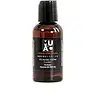What's inside
What's inside
 Key Ingredients
Key Ingredients

 Benefits
Benefits

 Concerns
Concerns

 Ingredients Side-by-side
Ingredients Side-by-side

Water
Skin ConditioningGlycolic Acid
BufferingGlycerin
HumectantHydroxyethyl Acrylate/Sodium Acryloyldimethyl Taurate Copolymer
Emulsion StabilisingRubus Idaeus Seed Oil
EmollientPotassium Hydroxide
BufferingMandelic Acid
AntimicrobialGluconolactone
Skin ConditioningSalix Nigra Bark Extract
Skin ProtectingMalic Acid
BufferingPyrus Malus Fruit Extract
Skin ConditioningAllantoin
Skin ConditioningVaccinium Macrocarpon Fruit Extract
AstringentLactic Acid
BufferingAzelaic Acid
BufferingGlycyrrhiza Glabra Root Extract
BleachingLeuconostoc/Radish Root Ferment Filtrate
AntimicrobialSodium Phytate
Melia Azadirachta Leaf Extract
Skin ConditioningMelia Azadirachta Flower Extract
Skin ConditioningCorallina Officinalis Extract
Skin ConditioningAnanas Sativus Fruit Extract
Skin ConditioningCitric Acid
BufferingCurcuma Longa Root Extract
MaskingTocopherol
AntioxidantOcimum Basilicum Flower/Leaf Extract
TonicOcimum Sanctum Leaf Extract
Skin ConditioningLactobacillus/Punica Granatum Fruit Ferment Extract
Skin ConditioningLactobacillus/Pumpkin Fruit Ferment Filtrate
Skin ConditioningHydrolyzed Fibroin
Skin Conditioning1,2-Hexanediol
Skin ConditioningCaprylyl Glycol
EmollientPotassium Sorbate
PreservativeSodium Benzoate
MaskingWater, Glycolic Acid, Glycerin, Hydroxyethyl Acrylate/Sodium Acryloyldimethyl Taurate Copolymer, Rubus Idaeus Seed Oil, Potassium Hydroxide, Mandelic Acid, Gluconolactone, Salix Nigra Bark Extract, Malic Acid, Pyrus Malus Fruit Extract, Allantoin, Vaccinium Macrocarpon Fruit Extract, Lactic Acid, Azelaic Acid, Glycyrrhiza Glabra Root Extract, Leuconostoc/Radish Root Ferment Filtrate, Sodium Phytate, Melia Azadirachta Leaf Extract, Melia Azadirachta Flower Extract, Corallina Officinalis Extract, Ananas Sativus Fruit Extract, Citric Acid, Curcuma Longa Root Extract, Tocopherol, Ocimum Basilicum Flower/Leaf Extract, Ocimum Sanctum Leaf Extract, Lactobacillus/Punica Granatum Fruit Ferment Extract, Lactobacillus/Pumpkin Fruit Ferment Filtrate, Hydrolyzed Fibroin, 1,2-Hexanediol, Caprylyl Glycol, Potassium Sorbate, Sodium Benzoate
 Reviews
Reviews

Ingredients Explained
These ingredients are found in both products.
Ingredients higher up in an ingredient list are typically present in a larger amount.
Malic Acid is an acid with both AHA and BHA properties, but is considered an AHA because its AHA properties are stronger.
It can be naturally found in unripe fruit and especially apples (its name from the latin word "malum", meaning apple!).
Like other AHAs, malic acid gently removes the top layer of dead skin cells to reveal smoother, brighter skin underneath.
Though it’s considered milder and less potent than glycolic or lactic acid, it can help improve:
Due to its larger molecular structure, it penetrates the skin more slowly and is often used in combination with other AHAs to enhance their overall effectiveness.
Malic acid often plays a role in balancing a product’s pH and is usually included in small amounts (around 1-2%) as a supporting exfoliant.
As with all exfoliating acids, you should wear sunscreen daily when using malic acid to protect your newly resurfaced skin.
Fun fact: Malic acid is the compound responsible for the tart flavor of apples and other sour fruits.
While research on malic acid is limited compared to glycolic or lactic acid, it’s still a safe and mild exfoliant.
Read more about some other popular AHA's here:
Learn more about Malic AcidMandelic Acid is an alpha hydroxy acid (AHA).
Like other AHAs, it helps exfoliate the surface of the skin by breaking down the bonds that hold dead skin cells together. This helps reveal smoother and brighter skin underneath.
Mandelic acid helps with:
Due to it having a larger molecular size than glycolic acid, mandelic acid is able to penetrate the skin more slowly and evenly. This makes it gentler and less irritating, making it a great option for sensitive or beginner skin.
Despite being milder, mandelic acid is still an effective exfoliant that improves skin texture and tone over time.
What makes mandelic acid stand out from other AHAs? It has antibacterial and antioxidant properties.
These traits make it a great option for acne-prone or problem skin by reducing active breakouts and fading post-acne marks. Studies show that mandelic acid (especially when combined with salicylic acid) can significantly reduce pimples and hyperpigmentation while causing fewer side effects than stronger acids.
Mandelic acid is effective in concentrations of 5% and up with an ideal pH range of 3-4 for at-home use.
Like other AHAs, it’s important to wear sunscreen daily to protect your newly exfoliated skin.
However, unlike glycolic acid, mandelic acid is light-sensitive. Be sure your mandelic acid is packaged in opaque containers to ensure it stays stable and effective.
In short, mandelic acid is a gentle yet powerful AHA that exfoliates, brightens, and helps clarify skin while keeping irritation low. Its antibacterial action makes it especially beneficial for those with acne-prone, sensitive, or uneven skin, offering smoother, clearer, and more even-toned results over time.
Read more about some other popular AHA's here:
Learn more about Mandelic AcidWater. It's the most common cosmetic ingredient of all. You'll usually see it at the top of ingredient lists, meaning that it makes up the largest part of the product.
So why is it so popular? Water most often acts as a solvent - this means that it helps dissolve other ingredients into the formulation.
You'll also recognize water as that liquid we all need to stay alive. If you see this, drink a glass of water. Stay hydrated!
Learn more about Water